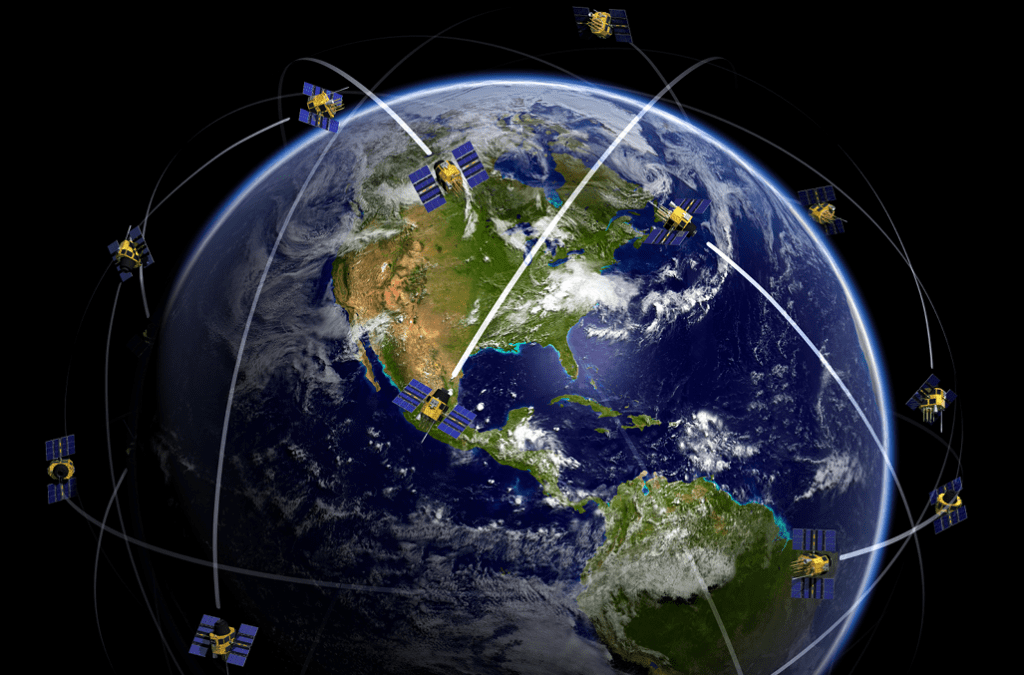
The enormous demand for faster and ubiquitous connectivity has prompted the use of satellites well beyond their initial military and scientific applications. Integrating satellite technology into existing infrastructure propels businesses toward scalable network and connectivity solutions. LEO satellites are quickly bridging the gap between urban and remote area connectivity and slow and fast networks.
This blog will explore Low Earth Orbit satellites, their uses, as well as some of the pros and cons of these satellites. Discover how LEO satellites compare to MEO and GEO satellites and why the difference is relevant. Find out how you can achieve reliable, high-speed and low latency connectivity anywhere in the world through MetTel’s secure connectivity solutions.
What is a Low Earth Orbit (LEO) Satellite?
A Low Earth Orbit satellite (LEO) operates closest to our planet. LEO satellites typically have an orbital range between 100 and 1,200 miles (160-2,000 km) above the Earth’s surface. To put those numbers in perspective, Mt. Everest is 5.5 miles above sea level and passenger planes reach their ceiling just under 7.5 miles above sea level.
These LEO satellites complete an orbit within 90 to 120 minutes, allowing them to communicate with all locations below their orbital path daily, in 90-minute increments. Thanks to their accessibility and observational advantages, Low Earth Orbit satellites help with communication services, Earth observation, navigation, science, defensive surveillance, and human spaceflight applications.
Due to their proximity to Earth, LEO satellites provide low latency, global coverage, and high bandwidth; they are useful for governments and businesses seeking more alternative reliable communication solutions.
What Are LEO Satellites Used For?
LEO satellites provide many of our everyday services. They deliver high-speed internet, monitor Earth’s surface through imaging, enable global navigation systems by broadcasting timing and location data, support scientific research through microgravity experiments, observe space and provide temporary housing in Space Stations that execute vital experiments for scientists. These satellites also assist militaries with surveillance and asset tracking.
Increased demand for broadband connectivity, especially in remote areas, has driven massive investments in LEO constellations that offer low-latency, high-speed connectivity solutions. As such, some analysts predict the LEO satellite market to soar to USD 23.2 billion by 2029 from USD 12.6 billion in 2024. These satellites will also provide supplemental cellular coverage for Mobile Network Operators (AT&T, Verizon, T-Mobile, etc.) by next year.
Pros and Cons of LEO Satellites
While these satellites have many uses, there are some areas where Low Earth Orbit satellites are less effective than other kinds of satellites. Here are a few of the benefits and drawbacks of LEO satellites.
Pros of LEO satellites:
- Low latency: Being closer to Earth, signals to and from LEO satellites experience low latency, which makes real-time applications like video conferencing and calls more efficient.
- Improved coverage: Traditional geostationary satellites provide blanket coverage with fewer satellites but leave gaps depending on location, particularly at higher latitudes. LEOs’ proximity can support line-of-sight access even to remote areas, like polar zones, developing regions, and islands.
- Resilience: By utilizing many LEO satellites in their networks, providers gain redundancy, improving their services’ resilience and continuity.
- Superior data throughput: Fast LEO network transmission facilitates high-throughput broadband connecting first responders in disaster zones and remote or rural areas.
- Cost of Deployment: The cost of deploying LEO satellites is much less than MEO or GEO satellite constellations.
Cons of LEO satellites:
- Short lifespan: LEO satellites have relatively short operational lives of 5-7 years due to degradation from radiation exposure and the drag of traveling at 17,500 mph in the densest orbital atmosphere.
- Congestion risks: With thousands of Low Earth Orbit satellites projected to be launched, space traffic management is an emerging challenge to avoid collisions and prevent orbital debris.
- Terrestrial interference: Signals can experience disruption or possibly disrupt MEO and GEO constellations. Signals can also possibly affect Radio Astronomy farms on Earth.
- Light Pollution: LEO satellites can reflect the sun and interrupt large and small observatories from seeing space pristinely.
What is a Medium Earth Orbit (MEO) Satellite?
A Medium Earth Orbit (MEO) satellite orbits Earth between 1,200 and 22,236 miles (2,000-37,7786 km) above sea level. The primary function of these intermediate orbits is navigation. Major global navigation systems like GPS use MEO satellites in intermediate circular orbits (ICO) to provide precise positioning and timing signals.
What Are MEO Satellites Used For?
As mentioned, Medium Earth Orbit satellites are often used in GPS tracking, but they also have other applications as MEO enables mobile communications over broad coverage areas. They provide decent bandwidth, variable latency, and coverage advantages for communications and connectivity-supporting applications that can work within these requirements. An antenna/dish or Earth station can stay connected to a single satellite for much longer than a LEO satellite, requiring less logic for communicating with multiple satellites and maintaining constant service with fewer satellites.
Medium Earth Orbit satellites’ expansive visibility from orbit makes media broadcasting possible and facilitates “near real-time” services like television, radio, and internet access. Governments and militaries also rely on MEO satellites for reliable and secure communications.
Pros and Cons of MEO Satellites
MEO’s intermediate positioning offers some advantages, including:
- Low latency: Medium Earth Orbit satellites have lower latency than GEO constellations, which enables near real-time communications.
- Global coverage: Compared to LEO, Medium Earth Orbit satellites provide global coverage with a relatively smaller number of satellites. In fact, 24 positioned in the correct orbits can support global communications.
- Less frequent handovers: MEO satellites remain in view for much longer than LEO satellites, requiring fewer handovers, which can translate to more stable connections.
MEO satellites have a few disadvantages, including:
- Limited coverage area: The orbital altitude of MEOs limits the footprint of individual satellites, requiring more satellites to attain global coverage than geostationary satellites.
- More complicated orbital mechanics: Maintaining satellites in MEO orbit is more complex than in LEO or GEO.
- Latency: MEO satellites introduce additional latency in data transmission when compared to LEO constellations due to the distance between the satellites and Earth.
What is a Geostationary Earth Orbit (GEO) Satellite?
Geostationary satellites orbit the Earth at an altitude of approximately 22,236 miles (35,786 km) above sea level and are centered along the Earth’s equator. Their orbital period matches the Earth’s 24-hour rotation period, and they move in the same direction as Earth: west to east. At their altitude, geostationary satellites appear stationary from Earth, and any observer from the ground wouldn’t notice any movement.
The satellites provide continuous connectivity through RF communications, enabling applications like broadcast TV, communications, and weather monitoring that require constant visibility from an exact location relative to the Earth.
What Are GEO Satellites Used For?
GEO satellites enable global telecommunications networks for phones, the internet, and media broadcasting. Mobile Satellite Services (MSS) were born from these satellites. They also power weather monitoring satellites, provide real-time weather updates, support GPS navigation, and serve military communications networks. These satellites have sensors that gather remote data on natural resources, disasters like wildfires, and climate change.
Pros and Cons of GEO Satellites
GEO satellites have many benefits, including greater reliability and superior navigational capabilities due to their static space positioning. Here are some other pros of GEO satellites:
- Constant visibility: Geostationary satellites provide continuous, uninterrupted coverage over a large area by remaining fixed in the sky.
- Wide coverage area: A single satellite can service around one-third of the Earth’s surface in its coverage zone.
- Reliable signal: Interference is minimal with highly directional antennas focused on the satellite.
- Long operational lifespan: Geostationary satellites can typically operate for 15-20 years before replacement.
Geostationary satellites also come with limitations such as:
- High latency: Due to their distance, geostationary satellites have a signal delay that limits time-sensitive applications like video calls and other real-time applications.
- Limited capacity: Only a finite number of GEO satellites can occupy orbital slots without risk of collisions or interference. In fact, the orbit is highly regulated at this point.
- Expensive launches: The fuel needed to reach high altitude orbit increases launch costs significantly.
- Difficult to access: Their orbital height makes GEOs impractical to physically service, repair, or replace.
LEO vs MEO vs GEO Satellites: What’s the Difference?
LEO, MEO, and GEO satellites form a global connectivity infrastructure that supports diverse users and applications worldwide, but they have a few distinctions. Understanding these differences helps IT operators select the optimal orbits for network connectivity, communication, imaging, and navigation services.
The three satellites’ orbital altitude differences impact coverage areas, visibility duration, and signal latency. A Low Earth Orbit satellite is ideal for real-time applications needing low latency, while GEO favors applications requiring continuous stationary coverage like low bandwidth IoT devices. MEO provides a middle ground, trading off coverage versus latency. As businesses look to upgrade global connectivity services, evaluating MEO vs LEO vs GEO satellites will help them understand which type best supports their application needs from a network requirements and business goals perspective.
High-Speed Satellite Broadband from MetTel
Low Earth Orbit satellite networks maximize coverage, performance, and bandwidth to deliver global connectivity even in remote areas, enabling commercial and government applications worldwide.
At MetTel, we leverage these resources to give your business access to satellite broadband services, including Starlink, for all applications with a continuously diverse network, even during disasters. Simplify management and scale with MetTel’s managed SD-WAN services and experience increased coverage, network performance, and the security that every modern business requires. Get started with MetTel today!


